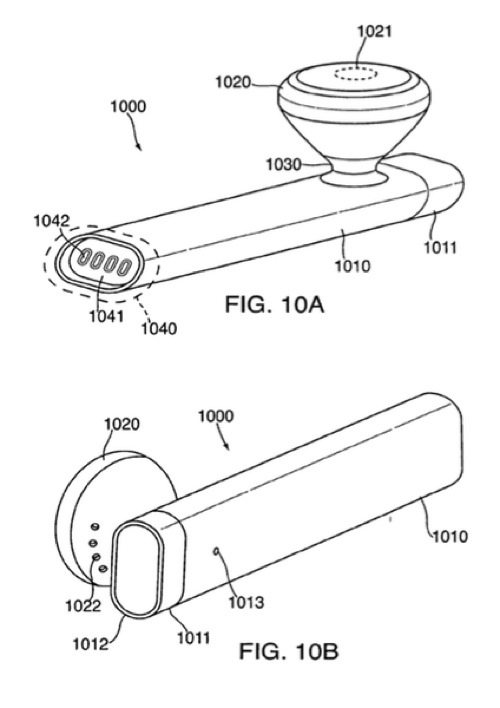Apple is working on a wireless headset having adaptive powering, according to a new patent (number 20120212063) at the U.S. Patent & Trademark Office.
A system that includes a bus, a battery, core processing circuitry, radio frequency (RF) processing circuitry, first power regulating circuitry, second power regulating circuitry, and control circuitry is provided. The bus can be coupled to receive power from a source external to the system. The core processing circuitry and RF processing circuitry can be selectively coupled to each other via a switch. The switch can be operative to turn ON and OFF based on a signal level received on the bus.
The first power regulating circuitry can be electrically coupled to the bus, the core processing circuitry, and the switch. The second power regulating circuitry can be electrically coupled to the battery, the RF processing circuitry, and the switch. The control circuitry can be operative to selectively turn ON and OFF the first power regulating circuitry and the second power regulating circuitry based on a number of monitored conditions.
Here’s Apple’s background and summary of the invention: “Headsets for providing hands-free communications are known in the art. Such headsets typically can be used in conjunction with a cellular telephone or a computer (e.g., Voice over IP). Some existing headsets include a microphone, a speaker (also referred to as a receiver), electronics for controlling the headset and communicating with another device (e.g., a cellular telephone), a battery and a connector for re-charging the battery.
“There are many aspects involved in the design of headsets. For example, the size and weight of headsets can be key issues because of how they typically mount to a user’s ear. A heavy or large headset can pull on a user’s ear, creating an uncomfortable fit. The shape of headset earpieces (e.g., earbuds) may also be an important design consideration to take into account as it is desirable for earpieces to fit comfortably in, on, or over a wide range of different sizes and shapes of ears.
“Additionally, the acoustic performance of headsets, such as receiver sound generation quality and microphone sound reception quality (e.g., ability to pick up a user’s voice without undue background noise), can be important design considerations. Achieving desired receiver and microphone acoustic performance can become increasingly difficult as the size of a headset decreases.
“Another example of an important design consideration can be the user interface of a headset. It may be desirable for a user interface to be intuitive for a first-time user, yet convenient for an experienced user.
“Aesthetics may be yet another important design consideration for headsets.
“Further still, ease of manufacturing headsets can be another design consideration. For example, it can be desirable to design a headset that can be mass produced in an affordable fashion.
“In view of the foregoing, there is a need for an improved headset that addresses one or more of the above-identified considerations.
“In accordance with one embodiment of the present invention, a system that includes a bus, a battery, core processing circuitry, radio frequency (RF) processing circuitry, first power regulating circuitry, second power regulating circuitry, and control circuitry is provided. The bus can be coupled to receive power from a source external to the system. The core processing circuitry and RF processing circuitry can be selectively coupled to each other via a switch.
“The switch can be operative to turn ON and OFF based on a signal level received on the bus. The first power regulating circuitry can be electrically coupled to the bus, the core processing circuitry, and the switch. The second power regulating circuitry can be electrically coupled to the battery, the RF processing circuitry, and the switch. The control circuitry can be operative to selectively turn ON and OFF the first power regulating circuitry and the second power regulating circuitry based on a number of monitored conditions.
“In accordance with another embodiment of the present invention, a method for regulating power in a headset that includes first power regulating circuitry, second power regulating circuitry, core processing circuitry, and radio frequency (RF) processing circuitry is provided. The method can include monitoring a bus power level. The method can include monitoring a battery charge level.
“The method can include selectively powering the core processing circuitry using the first power regulating circuitry based on the monitored bus power level and battery charge level. The method can include selectively powering the RF processing circuitry using the second power regulating circuitry based on the battery charge level.
“In accordance with yet another embodiment of the present invention, a wireless headset system that includes processor circuitry and power distribution circuitry is provided. The processor circuitry can include a first power consumption portion and a second power consumption portion. The power distribution circuitry can be operative to selectively power the first power consumption portion independent of whether the second power consumption portion is powered.”
Jeffrey L. Terlizzi is the inventor.

